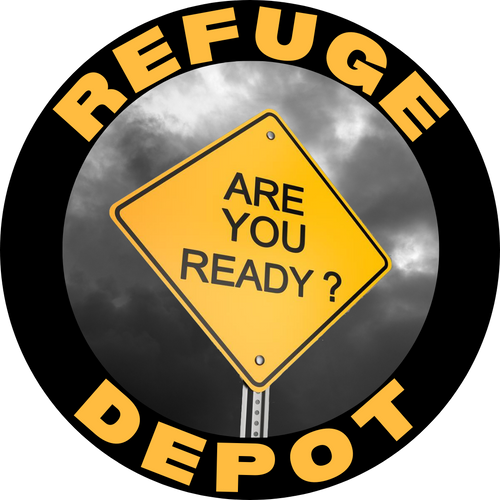
What is micro environment - emergency preparedness
Share
An emergency preparedness micro environment refers to your immediate personal space or small-scale environment that you can control and prepare for emergencies. Think of it as your "personal bubble" of preparedness—typically your home, car, workplace, or even what you carry on your person daily.
In any major emergency—be it an earthquake, extended power outage, severe storm, or civil unrest—public services (police, fire, EMS) will be overwhelmed, and infrastructure (power, water, roads) may fail. The "macro" environment (your city, neighborhood) becomes chaotic and unpredictable.
The concept recognizes that while you can't control large-scale disasters or the broader environment (the "macro"), you can control your immediate surroundings to maximize your safety and resilience when emergencies strike.
Think of it as your immediate, personal sphere of control and survival.
Shop our Winter Collection to find items in article
Your Micro Environment is the small, manageable space where you can create a bubble of safety, sustenance, and comfort. It's the area you can directly influence, typically encompassing:
* Your body (the clothes you're wearing, your physical health).
* Your immediate vicinity (the room you are in, your desk at work, the seat of your car).
* Your home (your apartment or house).
* Your vehicle.
The goal is to have the necessary resources within this micro-environment to survive and manage for a period of time—typically 72 hours to 2 weeks—without any external help.
What Should a Person Have in Their Micro Environment?
We'll structure this using the "CORE" principle, which stands for Carry, Office, Road, Home. This ensures you're covered in every micro-environment you inhabit.
1. C - CARRY (On Your Person / Everyday Carry - EDC)
This is the most immediate level. These are items you have *on you* at all times (in your pockets, on your keychain, in a small pouch). You'll have these even if you have to abandon everything else.
* Purpose: To solve immediate, common problems and handle the first few minutes of a crisis.
* Key Items:
* Phone & Charger Cable: A compact battery bank is a huge plus.
* Wallet: With some cash (small bills) and a copy of your ID.
* Pocket Knife or Multi-Tool: (e.g., Leatherman, Swiss Army Knife).
* Pen & Small Notebook: For leaving notes or recording information.
* Tactical Pen or Strong Pen: Can be used for self-defense or breaking glass.
* Personal Light Source: A small, bright LED flashlight.
* Lighter or Waterproof Matches: For creating fire.
* Personal Hygiene Items: Tissues, wet wipes, a few Band-Aids.
* Paracord Bracelet: Several feet of strong cordage in a wearable form.
* Whistle: To signal for help without shouting yourself hoarse.
2. O - OFFICE (Get Home Bag - GHB)
This is a small bag or kit you keep at your workplace or in your locker at school. Its sole purpose is to get you safely from your location back to your home or your vehicle.
* Purpose: To provide the resources for a 3-24-hour journey on foot.
* Key Items:
* Sturdy Backpack: To carry everything.
* Comfortable Walking Shoes & Socks: You can't walk 10 miles in dress shoes or heels.
* Water: A bottle of water and/or a small filter/life straw.
* High-Calorie Snacks: Protein bars, nuts, dried fruit.
* Basic First-Aid Kit: More substantial than your EDC.
* Light & Communication: Headlamp, extra batteries, a hand-crank or battery-powered radio.
* Warmth & Shelter: A compact emergency blanket (Mylar), a light poncho, an extra layer of clothing (fleece).
* Local Map & Compass: In case the GPS is down.
* Basic Tools: A better multi-tool, work gloves, duct tape.
* Personal Items: A photo of your family, any essential medications for 1-2 days.
3. R - ROAD (Vehicle Kit)
Your car is a mobile micro environment. You could be stranded due to weather, a breakdown, or a road closure.
* Purpose: To keep you safe, warm, and able to either fix your car or wait for help for up to 72 hours.
* Key Items:
* Car Safety: Jumper cables, tire sealant/inflator, basic tool kit, ice scraper.
* Warmth & Shelter: A warm blanket or sleeping bag, extra winter clothes (hat, gloves, jacket), a Mylar emergency bivvy sack.
* Water & Food: A case of bottled water and non-perishable food (canned goods, granola bars). *Don't forget a manual can opener!*
* Light & Signaling: Flashlight, headlamp, flares or LED road flares, a brightly colored bandana or "Help" sign to attract attention.
* First-Aid Kit: More comprehensive than your GHB kit.
* Sanitation: Toilet paper, hand sanitizer, and garbage bags.
* Traction Aids: Cat litter or traction mats for getting out of snow/mud.
4. E - HOME (Emergency Supplies)
This is your main base—your primary micro environment. This is where you can "hunker down" and ride out a prolonged crisis.
* Purpose: To allow you to live self-sufficiently for a minimum of 3 days, but ideally 2 weeks.
* Key Items (The Core Four):
1. Water: 1 gallon per person per day. Store at least a 3-day supply, but a 2-week supply is the gold standard. Have water purification methods (filters, tablets) as well.
2. Food: A supply of non-perishable, easy-to-prepare food (canned goods, dry pasta, rice, beans, peanut butter, canned meats, etc.). Don't forget food for pets!
3. Light & Power: Multiple flashlights, headlamps, a LOT of extra batteries, and lanterns. Consider a solar or hand-crank charger for phones. A generator is a major upgrade if feasible.
4. First-Aid & Sanitation: A comprehensive first-aid kit. Also, have a plan for hygiene without running water: garbage bags, toilet liners, kitty litter, moist towelettes, and bleach for disinfecting.
* Additional Critical Home Items:
* Communication: A NOAA Weather Radio (hand-crank or battery-powered) to receive emergency alerts.
* Tools & Safety: A fire extinguisher, a wrench to turn off gas/water, a manual can opener, duct tape, and plastic sheeting (for sealing windows or creating a shelter).
* Warmth & Cooking: A way to cook without power (camp stove, BBQ *used outdoors only*), warm blankets, sleeping bags.
* Cash: ATMs and credit card machines will not work in a power outage.
* Important Documents: Copies of insurance policies, IDs, and bank records in a waterproof container.
* Entertainment & Comfort: Books, games, cards. Mental health is a critical part of survival.
The Most Important Thing to Have
Beyond any single item, the most crucial element of your micro environment is knowledge and a plan.
* Do you know how to turn off your gas and water?
* Does your family have a meeting place if you get separated?
* Have you practiced "sheltering in place" or evacuating from your home?
Start small. Build your Carry kit today. Then, over the next few weeks, assemble your Get Home Bag. Building your micro environment is a process, not a single trip to the store. By taking these steps, you move from being a potential victim to a resilient, prepared individual.
__________________________________________
When the Power Goes Out
It started with freezing rain on a January evening—the kind that coats everything in glass. By midnight, the weight of ice brought down power lines across three counties. No big deal, you thought. The utility company will have it fixed by morning.
But morning came, and the house was silent. No hum of the furnace. No lights. And the temperature inside was already dropping.
By the second day, it hit you: the grocery store was closed, gas stations couldn't pump fuel, and your phone was nearly dead. The water in the pipes began to freeze. Your neighbor knocked to ask if you had any candles—theirs had run out.
This is when your micro environment becomes your lifeline.
The blankets you stored. The flashlights with fresh batteries. The case of water bottles in the basement. The propane camping stove you can use to heat soup. The battery-powered radio that tells you the power won't be back for five more days.
Winter doesn't just make emergencies uncomfortable—it makes them dangerous. Hypothermia can set in within hours in an unheated home. Frozen pipes can burst, causing thousands in damage. Roads become impassable, cutting you off from help.
Your micro environment isn't about fear. It's about control when winter takes everything else away. It's the difference between surviving and thriving when the world outside freezes over.
Find more life-saving winter preparedness tips in Winter Ready
Winter Ready: Your Ultimate Guide to Winter Preparedness
Are you prepared for the harsh realities of winter? This comprehensive e-book equips you with essential knowledge and practical tips to ensure your safety and comfort during the coldest months.
Inside, you'll discover:
- Understanding Winter Weather: Learn to recognize and respond to various winter weather conditions, including blizzards, ice storms, and extreme cold.
- Weatherization for Your Home: Discover effective strategies to insulate your home, seal drafts, and protect against freezing temperatures.
- Car Maintenance: Ensure your vehicle is winter-ready with essential maintenance tasks and emergency supplies.
- Physical and Mental Preparedness: Maintain your physical and mental well-being during the winter months with practical advice and coping strategies.
- Survival Items and Gear: Assemble a comprehensive emergency kit with essential supplies for survival in harsh winter conditions.
- Power Outages Preparedness: Be prepared for power outages with alternative heating and lighting solutions.
- Winter Insurance Considerations: Review your insurance coverage to ensure you're adequately protected during winter emergencies.
- Community Resources and Organizations: Connect with local organizations and resources for support and assistance.
- Emergency Planning and Evacuation: Develop a family emergency plan and understand evacuation procedures.
- Conclusion and Final Tips: Recap key points and offer additional advice for staying safe and comfortable during winter.
With valuable links to community resources, emergency supplies, first aid kits, weatherization items, insurance providers, and more, this e-book is your one-stop resource for winter preparedness.
Author: Steven Muhammad
Publisher: Refuge Depot
- Paperback & Kindle - Amazon: https://a.co/d/a6mWGXR
- eBook - Shopify: https://refugedepot.myshopify.com/products/winter-ready-your-ultimate-guide-to-winter-preparedness
- eBook -Gumroad: https://refugehaven.gumroad.com/l/winterready?layout=profile


